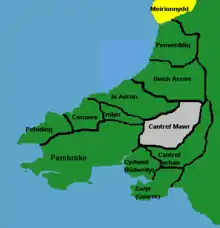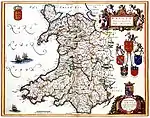Deheubarth
Deheubarth (Welsh pronunciation: [dɛˈhəɨbarθ]; lit. "Right-hand Part", thus "the South")[4] was a regional name for the realms of south Wales, particularly as opposed to Gwynedd (Latin: Venedotia). It is now used as a shorthand for the various realms united under the House of Dinefwr, but that Deheubarth itself was not considered a proper kingdom on the model of Gwynedd, Powys, or Dyfed[5] is shown by its rendering in Latin as dextralis pars or as Britonnes dexterales ("the Southern Britons") and not as a named land.[6] In the oldest British writers, Deheubarth was used for all of modern Wales to distinguish it from Hen Ogledd (Y Gogledd), the northern lands whence Cunedda and the Cymry originated.[7]
Kingdom of Deheubarth Teyrnas Deheubarth | |||||||||||
|---|---|---|---|---|---|---|---|---|---|---|---|
| 920–1197 | |||||||||||
 Banner of the House of Dinefwr
 Coat of arms
| |||||||||||
 Medieval kingdoms of Wales. | |||||||||||
| Capital | Dinefwr | ||||||||||
| Common languages | Welsh | ||||||||||
| Government | Monarchy | ||||||||||
• 920–950 | Hywel Dda | ||||||||||
• 1081 | Rhys ap Tewdwr | ||||||||||
• 1155–1197 | Rhys ap Gruffydd | ||||||||||
| Historical era | Middle Ages | ||||||||||
• Established | 920 | ||||||||||
• Disestablished | 1197 | ||||||||||
| Currency | ceiniog cyfreith & ceiniog cwta | ||||||||||
| |||||||||||
History


Part of a series on the |
|---|
| History of Wales |
 |
|
|
Deheubarth was united around 920 by Hywel Dda out of the territories of Seisyllwg and Dyfed, which had come into his possession. Later on, the Kingdom of Brycheiniog was also added. Caerleon was previously the principal court of the area, but Hywel's dynasty fortified and built up a new base at Dinefwr, near Llandeilo, giving them their name.
After the high-water mark set by Hywel, Dinefwr was repeatedly overrun. First, by the Welsh of the north and east: by Llywelyn ap Seisyll of Gwynedd in 1018; by Rhydderch ab Iestyn of Morgannwg in 1023; by Gruffydd ap Llywelyn of Gwynedd in 1041 and 1043. In 1075, Rhys ab Owain and the noblemen of Ystrad Tywi succeeded in treacherously killing their English-backed overlord Bleddyn ap Cynfyn. Although Rhys was quickly overrun by Gwynedd and Gwent, his cousin Rhys ap Tewdwr – through his marriage into Bleddyn's family and through battle – restablished his dynasty's hegemony over south Wales just in time for the second wave of conquest: a prolonged Norman invasion under the Marcher Lords. In 1093, Rhys was killed in unknown circumstances while resisting their expansion into Brycheiniog and his son Gruffydd was briefly thrown into exile.
Following the death of Henry I, in 1136 Gruffydd formed an alliance with Gwynedd for the purpose of a revolt against Norman incursions. He took part in Owain Gwynedd and Cadwaladr ap Gruffydd's victory over the English at Crug Mawr. The newly liberated region of Ceredigion, though, was not returned to his family but annexed by Owain.
The long and capable rule of Gruffydd's son the Lord Rhys – and the civil wars that followed Owain's death in Gwynedd – briefly permitted the South to reassert the hegemony Hywel Dda had enjoyed two centuries before. On his death in 1197, though, Rhys redivided his kingdom among his several sons and none of them ever again rivalled his power. By the time Llywelyn the Great won the wars in Gwynedd, in the first half of the 12th century, lords in Deheubarth merely appear among his clients.
Following the conquest of Wales by Edward I, the South was divided into the historic counties of Cardiganshire, Carmarthenshire and Pembrokeshire by the Statute of Rhuddlan.
Religion
In the arena of the church, Sulien was the leader of the monastic community at Llanbadarn Fawr in Ceredigion. Born ca. 1030, he became Bishop of St David's in 1073 and again in 1079/80. Both of his sons followed him into the service of the church. At this time the prohibition against the marriage of clerics was not yet established. His sons produced a number of manuscripts and original Latin and vernacular poems. They were very active in the ecclesiastical and political life of Deheubarth. One son, Rhygyfarch (Latin: Ricemarchus) of Llanbadarn Fawr, wrote the Life of Saint David and another, Ieuan, was a skillful scribe and illuminator. He copied some the works of Augustine of Hippo and may have written the Life of St. Padarn.
See also
- Goronwy Foel
- House of Dinefwr
- List of Welsh kings
References
- Wade-Evans, Arthur. Welsh Medieval Law. Oxford Univ., 1909. Accessed 1 Feb 2013.
- Bradley, A.G. Owen Glyndwr and the Last Struggle for Welsh Independence. G.P. Putnam's Sons (New York), 1901. Accessed 1 Feb 2013.
- Jenkins, John. Poetry of Wales Archived 2008-06-07 at the Wayback Machine. Houlston & Sons (London), 1873. Accessed 1 Feb 2013.
- The orientation of Medieval maps and geographical thinking was towards the east. Facing east, north was thus on the "left-hand" side and south on the right.
- Ellis, Thos. P. Welsh Tribal Law & Custom in the Middle Ages, Vol. I, iii, §3. 1926. Accessed 1 February 2013.
- Wade-Evans, Arthur. Welsh Medieval Laws. Oxford Uni., 1909. Accessed 31 January 2013.
- Williams, Jane. A History of Wales. Cambridge University Press, 2010. Accessed 1 February 2013.
- The Welsh Academy Encyclopaedia of Wales. Cardiff: University of Wales Press, 2008 ISBN 978-0-7083-1953-6
